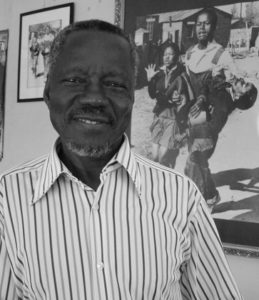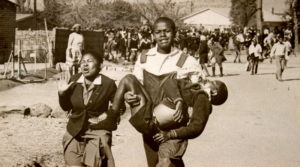A photo that made history

(c) Sam Nzima
June 16 is celebrated worldwide as the Day of the African Child. It is a special date. On 16 June 1976 the photographer Sam Nzima was commissioned to report on a demonstration in Soweto for the “black” South African newspaper The World. Soweto was the largest township in the southwest of Johannesburg. For weeks, an order of the apartheid regime had been causing growing wrath among the one and a half million black inhabitants.
The causes of the Soweto uprising
The lessons in the schools should also be held in Afrikaans, the language of the white Apartheid regime, the Burian elite. The black majority was once again declassed and unfairly disadvantaged. The students of Soweto took to the streets and demonstrated against the new decree. It had become known in the press that the police would also use firearms in an emergency. Everyone who had a camera that day rushed to Soweto to witness the event. Also Sam Nzima. At first the demo was peaceful, the students say the song “Nkosi Sikelele”, which was forbidden in South Africa at that time. The policemen fired aimlessly into the crowd, the students ran apart in panic. Another shot was fired, a boy fell to the ground fatally injured. It was 13-year-old Hector Pieterson. Sam Nzima was on the scene, he shot photos of an older boy picking up the injured student and carrying him out of the combat zone. It was Mbuyisa Makhubo. Hector’s stunned sister Antoinette ran beside him.

Hector Pieterson, Mbuyisa Makhubo and Hector’s sister Antoinette (c) Sam Nzima
Hector was already dead before Mbuyisa Makhubo could hoist him into the vehicle of Sam Nzima. The photographer hid the film in his sock just before he was stopped by police and forced to hand out his camera. In South Africa at that time it was forbidden to photograph the police during their missions.
What happened afterwards…
to Sam Nzima
The daily newspaper The World, run by black Africans and employing Sam Nzima, decided to publish the photos despite the ban. The world should see what happened in South Africa. Soon after, Sam Nzima was visited and threatened by the police. He had to choose between job and life. Nzima understood, he resigned. Nevertheless, he was sentenced to one year and seven months in prison. His photo, however, went around the world. It showed the trauma of the black population of South Africa, it shook up people all over the world. The photo marked a turning point, it was the beginning of the end of apartheid. It was not until decades later that Sam Nzima received the copyright to the photo. In August 2018 Sam Nzima died.
to Hector Pieterson
He was buried a few days later on the Avalon Cemetery. On June 16, 2002, the 26th anniversary of his death, the Hector Pieterson Museum was opened in Soweto’s township of Orlando. Nelson Mandela inaugurated the Hector Pieterson Memorial. Since 1991 the Day of the African Child reminds of Hector Pieterson, it became a symbol for children’s rights.
to Mbuyisa Makhubo
He was accused of having himself photographed with the deadly wounded student to discredit the white government and the police. Mbuyisa Makhubo disappeared because he had to expect a prison sentence. His family later reported that he had changed after the rescue of Hector Pieterson. He felt guilty that he could not save the boy. His disappeared. His family never heard from him again.
Every year on June 16th the Day of the African Child is celebrated, each year with another motto. In 2019, the theme is “Humanitarian Action in Africa: Children’s Rights First”. Children’s voices must have weight in decisions that affect their concerns and their future.
Angelika and the team of afrika4teens commemorates all those who participated in the 1976 Soweto uprising, especially Hector Pieterson, Sam Nzima and Mbuyisa Makhubo.



